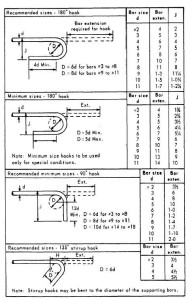Good design is essential for efficient construction, and Madison Concrete Construction has capabilities that include engineering consulting and support to collaborate with our engineering partners.
Rick Stone, Madison Concrete’s in-house engineer, serves as our expert for owners, designers and construction managers related to all things concrete as well as answer frequently asked questions.
 In previous columns, Rick has shared his expertise on high-strength concrete as well as how self-consolidating concrete differs from traditional concrete. This time, he address what a standard hook is and why they are changed on projects.]
In previous columns, Rick has shared his expertise on high-strength concrete as well as how self-consolidating concrete differs from traditional concrete. This time, he address what a standard hook is and why they are changed on projects.]
Q: What is a “standard hook”? And, why are you trying to change them on my project?
A: Every project has “hooked” reinforcing shown in at least one detail. Many drawings refer to “standard hooks” and show hooked bars in specific areas for top and bottom reinforcing.
ACI 318.7.1 defines three types: 90-degree hooks (those that have a 12 bar diameter extension on the “hook” leg pin to end), 180-degree hooks, and “stirrup and tie” hooks (those that have a 6- to 12-bar diameter extension on the “hook” leg pin to end, depending on bar diameter). Stirrup and tie hooks have a sub-definition for 135-degree bends. The 90-degree hooks with 12-bar diameter extensions are what we usually see drawn in typical details.
A Stirrup hook is further qualified in 318.12.13.2.1 as establishing the required anchorage when said hook encloses a longitudinal bar. There is no requirement for a longitudinal bar when the extension is 12db. There are restrictions based on yield strength and bar size, but for No. 5 and No. 4 bars, an extension of 6-bar diameters is sufficient to satisfy hook requirements as the hook encloses a longitudinal bar. While this addresses “Anchorage of Web Reinforcing,” it applies to all hook conditions. Web reinforcing is required to develop the tension strength of the bar to function and is wholly dependent on development above and below a diagonal shear crack but to do so it requires adequate anchorage. The ACI code (R12.13.2.1) assures this by requirement of the longitudinal bar: “For a No. 5 bar or smaller, anchorage is provided by a standard stirrup hook, as defined in 7.1.3, hooked around a longitudinal bar.”
We would love to hear from you about your structural engineering challenges and successes and the projects you’ve worked on involving standard hooks and stirrup hooks. Submit your questions to Rick at rstone@madisonconcrete.com To see our experience working on concrete projects, click here.